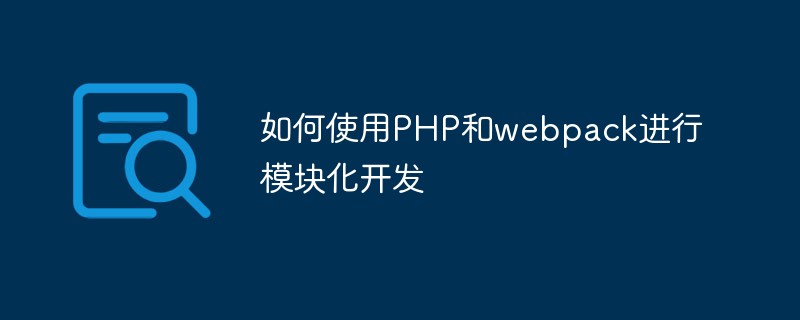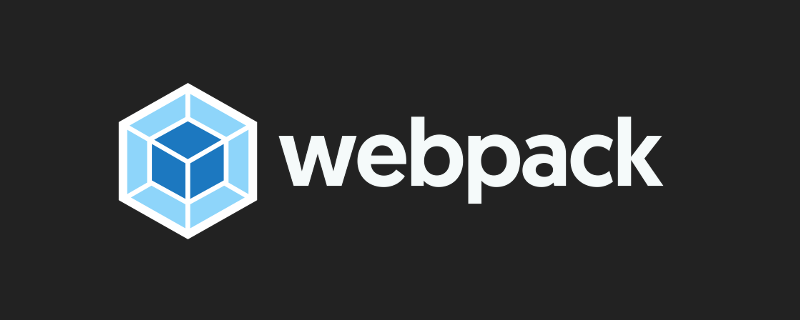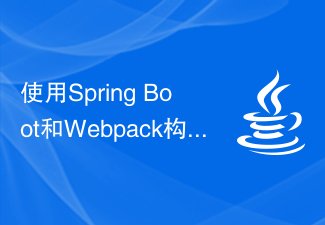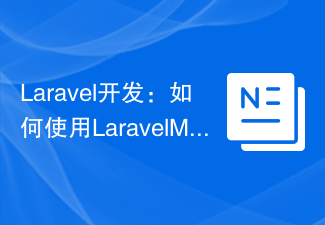This article brings you what is new in webpack4? What needs attention? It has certain reference value. Friends in need can refer to it. I hope it will be helpful to you.
While developers are still experiencing the afterglow of webpack3.x, webpack4.x has quietly arrived.
For users, the most anticipated questions are as follows:
What are the changes in the new version compared to the old version?
Migration from webpack3.x to webapck4.x?
What should we pay attention to when using webpack4.x?
New features of webpack
The power of webpack as a build tool lies in:
Many unique features can be configured in webpack.config.js;
Its configuration is flexible and changeable;
But because of this, That's also the bad thing about it. Because it is too casual, it is difficult to control, causing the following problems:
The cost of learning, using, and researching webpack is too high (the progression curve is too steep);
Building a small application also requires configuring webpack.config.js like building a large application (the sparrow is small but has all the internal organs);
And webpack4.x is a new The first generation version of webpack has greatly solved the existing problems.
webpackk4.x does not need to use the webpack.config.js configuration file
You can use the following 6 steps to complete the construction of the project:
-
Create one Project directory (webpack-demo), and then enter the changed directory
mkdir webpack-demo && cd webpack-demo
-
Initialize the package.json file
npm init -y
-
Load webpack and webpack-cli dependencies
npm install webpack webpack-cli --save-dev
Add the ~/src/index.js file to the project (index.js is the default entry file, and the default entry directory is ~/src. Of course, you can also customize the entry file. You need to modify the main configuration in package.json The item is the specified file)
index.js file code is as follows:
console.log('hello webpack.')
Open package.json and add the following code in the scripts configuration item:
"scripts": {
"build": "webpack"
}
Note: This is the NPM scripts command
Run the npm run build command, and then you will see a ~/dist/main.js file in the project. In the command window, you should notice the following warning prompt:
WARNING in configuration The 'mode' option has not been set, webpack will fallback to 'production' for this value. Set 'mode' option to 'development' or 'production' to enable defaults for each environment. You can also set it to 'none' to disable any default behavior. Learn more: https://webpack.js.org/concepts/mode/
Ignore this prompt message. We found that the project initialization configuration of webpack4.x is not much different from webpack3.x, but webpack4.x is missing. The required webpack.config.js configuration file.
Changes in packaging modeLet’s look back at the above prompt message. It means: 'If the configuration item of packaging mode is not set, then the default packaging mode is production mode (production), and for development Mode (development), you need to configure the mode configuration item. At this point, I think you readers should understand that webpack4. Save time and effort.
But in actual applications, we often distinguish between development mode and production mode, but this is not difficult in webpack4.x. Just modify the scripts in package.json as follows:
"scripts": {
"dev": "webpack --mode development", // 用于开发模式
"build": "webpack --mode production" // 用于生产模式
}
'right! webpack4.x is that simple’. We don't need to define two configuration files respectively for development mode and production mode like webpack3.x.
Overload the default configuration entry/exitThere is no configuration file webpack.config.js, which not only reduces our configuration workload, but also brings some questions to us who are just getting a glimpse of the method. For example: How to customize entrance/exit?
In the absence of webpack.config.js, we can add entry/exit configuration items in the command line, the code is as follows:
"scripts": {
"dev": "webpack --mode development ./src/entry.js --output ./dist/bundle.js", // 用于开发模式
"build": "webpack --mode production ./src/entry.js --output ./dist/bundle.min.js" // 用于生产模式
}
This is just without using webpack.config.js A plan.
The above are the overall changes that webpack4.x has brought to us.
But the function implementation in the module and plugins configuration items in the original webpack.config.js configuration file still requires the use of webpack.config.js. Although the webpack team's plan is to configure some commonly used loaders and plugins, only the UglifyJSPlugin built-in plug-in is implemented, which can compress *.js code without introducing it in production mode. Other loaders and plugins can only be introduced through webpack.config.js.
Webpack migration and precautions
Seeing these changes in webpack4.x, many people will not only ask whether the migration from webpack3.x to webpack4.x is easy Trouble, actually not troublesome, webpack4.x is backward compatible with webpack.3x.
In order not to introduce webpack.config.js, we used npm scripts. At that time, like the reloading of entrance/exit, we can also complete it in the webpack.config.js configuration file. The configuration is the same as the original are similar, but webpack4.x has the following issues that need attention:
升级到webpack4.x,你会发现在使用 extract-text-webpack-plugin 分离 *.css 出文件时经常出错,这是 extract-text-webpack-plugin 本身的问题,官方推荐使用 mini-css-extract-plugin 来避免问题的出现,但使用 mini-css-extract-plugin 有一个限制就是webapck须是4.2.0版本以上(较低的版本不支持)。
使用 使用babel-loader 转化ES6->ES5时将不需要 .babelrc 配置文件,你只需要在 package.json 的 scripts 中添加 --module-bind js=babel-loader 即可完成对 babel-loader 的配置。
其他的loader和plugin没有什么大的变化。其实讲到这里基本完了,下面是用webpack4.x构建的一个demo。
webpack4.x的demo
紧接上面的配置:
首先,添加 html-wepback-plugin 和 html-loader 依赖:
npm install html-webpack-plugin html-loader --save-dev
html-webpack-plugin生成html文件(html文件用来加载打包生成 bundle.js 文件),当然你也可以使用webpack支持的各种模板loader,这里使用 html-loader 支持的 *.html 类型模板来生成。
其次,添加 mini-css-extract-plugin 和 css-loader 依赖:
npm install mini-css-extract-plugin css-loader --save-dev
loader和plugin配置与webpack3.x类同,也可参考下面提供代码中的 webpack.config.js 文件。
然后,添加 babel-loader 、@babel/babel-core 和 @babel/babel-preset 依赖:
npm install @babel/core babel-loader @babel/preset-env --save-dev
loader和plugin配置与webpack3.x类同,也可参考下面提供源码中的 webpack.config.js 文件。
修改 package.json 中 scripts 如下:
"scripts": {
"dev": "webpack --mode development --module-bind js=babel-loader ./src/entry.js --output ./dist/bundle.js",
"build": "webpack --mode production ./src/entry.js --module-bind js=babel-loader --output ./dist/bundle.min.js"
},
最后,添加 webpack-dev-server 依赖,实现项目文件修改,浏览器及时刷新
npm install webpack-dev-server
在 package.json 中 scripts 的 dev 替换 webpack 为 webpack-dev-server 即可,代码如下:
"scripts": {
"dev": "webpack-dev-server --mode development --module-bind js=babel-loader ./src/entry.js --output ./dist/bundle.js",
"build": "webpack --mode production ./src/entry.js --module-bind js=babel-loader --output ./dist/bundle.min.js"
},
这样一个简单的demo就完成了。
其他的loader和plugin配置和webpack3.x类同。
The above is the detailed content of What's new in webpack4? What needs attention?. For more information, please follow other related articles on the PHP Chinese website!
 VUE3入门教程:使用Webpack进行打包和构建Jun 15, 2023 pm 06:17 PM
VUE3入门教程:使用Webpack进行打包和构建Jun 15, 2023 pm 06:17 PMVue是一款优秀的JavaScript框架,它可以帮助我们快速构建交互性强、高效性好的Web应用程序。Vue3是Vue的最新版本,它引入了很多新的特性和功能。Webpack是目前最流行的JavaScript模块打包器和构建工具之一,它可以帮助我们管理项目中的各种资源。本文就为大家介绍如何使用Webpack打包和构建Vue3应用程序。1.安装Webpack
 vite和webpack的区别是什么Jan 11, 2023 pm 02:55 PM
vite和webpack的区别是什么Jan 11, 2023 pm 02:55 PM区别:1、webpack服务器启动速度比vite慢;由于vite启动的时候不需要打包,也就无需分析模块依赖、编译,所以启动速度非常快。2、vite热更新比webpack快;vite在HRM方面,当某个模块内容改变时,让浏览器去重新请求该模块即可。3、vite用esbuild预构建依赖,而webpack基于node。4、vite的生态不及webpack,加载器、插件不够丰富。
 如何使用PHP和webpack进行模块化开发May 11, 2023 pm 03:52 PM
如何使用PHP和webpack进行模块化开发May 11, 2023 pm 03:52 PM随着Web开发技术的不断发展,前后端分离、模块化开发已经成为了一个广泛的趋势。PHP作为一种常用的后端语言,在进行模块化开发时,我们需要借助一些工具来实现模块的管理和打包,其中webpack是一个非常好用的模块化打包工具。本文将介绍如何使用PHP和webpack进行模块化开发。一、什么是模块化开发模块化开发是指将程序分解成不同的独立模块,每个模块都有自己的作
 vue webpack可打包哪些文件Dec 20, 2022 pm 07:44 PM
vue webpack可打包哪些文件Dec 20, 2022 pm 07:44 PM在vue中,webpack可以将js、css、图片、json等文件打包为合适的格式,以供浏览器使用;在webpack中js、css、图片、json等文件类型都可以被当做模块来使用。webpack中各种模块资源可打包合并成一个或多个包,并且在打包的过程中,可以对资源进行处理,如压缩图片、将scss转成css、将ES6语法转成ES5等可以被html识别的文件类型。
 Webpack是什么?详解它是如何工作的?Oct 13, 2022 pm 07:36 PM
Webpack是什么?详解它是如何工作的?Oct 13, 2022 pm 07:36 PMWebpack是一款模块打包工具。它为不同的依赖创建模块,将其整体打包成可管理的输出文件。这一点对于单页面应用(如今Web应用的事实标准)来说特别有用。
 webpack怎么将es6转成es5的模块Oct 18, 2022 pm 03:48 PM
webpack怎么将es6转成es5的模块Oct 18, 2022 pm 03:48 PM配置方法:1、用导入的方法把ES6代码放到打包的js代码文件中;2、利用npm工具安装babel-loader工具,语法“npm install -D babel-loader @babel/core @babel/preset-env”;3、创建babel工具的配置文件“.babelrc”并设定转码规则;4、在webpack.config.js文件中配置打包规则即可。
 使用Spring Boot和Webpack构建前端工程和插件系统Jun 22, 2023 am 09:13 AM
使用Spring Boot和Webpack构建前端工程和插件系统Jun 22, 2023 am 09:13 AM随着现代Web应用程序的复杂性不断增加,构建优秀的前端工程和插件系统变得越来越重要。随着SpringBoot和Webpack的流行,它们成为了一个构建前端工程和插件系统的完美组合。SpringBoot是一个Java框架,它以最小的配置要求来创建Java应用程序。它提供了很多有用的功能,比如自动配置,使开发人员可以更快、更容易地搭建和部署Web应用程序。W
 Laravel开发:如何使用Laravel Mix和Webpack优化文件大小?Jun 13, 2023 pm 04:44 PM
Laravel开发:如何使用Laravel Mix和Webpack优化文件大小?Jun 13, 2023 pm 04:44 PMLaravel开发:如何使用LaravelMix和Webpack优化文件大小?Laravel是一个非常流行的PHP框架,它提供了许多功能和工具,帮助开发者在构建Web应用程序时提高生产效率。其中,LaravelMix和Webpack是两个强大的工具,它们可以帮助您优化文件大小和提高性能。在本文中,我们将介绍如何使用LaravelMix和Webpack优


Hot AI Tools

Undresser.AI Undress
AI-powered app for creating realistic nude photos

AI Clothes Remover
Online AI tool for removing clothes from photos.

Undress AI Tool
Undress images for free

Clothoff.io
AI clothes remover

AI Hentai Generator
Generate AI Hentai for free.

Hot Article

Hot Tools

SublimeText3 Mac version
God-level code editing software (SublimeText3)

SublimeText3 Linux new version
SublimeText3 Linux latest version

SecLists
SecLists is the ultimate security tester's companion. It is a collection of various types of lists that are frequently used during security assessments, all in one place. SecLists helps make security testing more efficient and productive by conveniently providing all the lists a security tester might need. List types include usernames, passwords, URLs, fuzzing payloads, sensitive data patterns, web shells, and more. The tester can simply pull this repository onto a new test machine and he will have access to every type of list he needs.

WebStorm Mac version
Useful JavaScript development tools

SublimeText3 English version
Recommended: Win version, supports code prompts!






